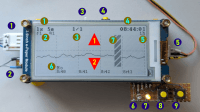Graphical Mains Frequency Logger


Energy Transition Live - update every second - 15 hours loop - DCF time - failure display
Grid frequency and grid voltage are important indicators of the load on an interconnected grid. Within such a grid, the frequency and phase of the generating components must be exactly the same. If deviations occur, the generators begin to work against each other, which in extreme cases can lead to severe damage or failure of the grid or parts of it. This highly dynamic system, consisting of many generators and millions of consumers, therefore needs to be constantly monitored and kept in balance.
Due to the increased feed-in of renewable energies such as wind and solar energy, this task has become significantly more complicated and, as a result, more difficult to balance. This is particularly evident on Sundays and public holidays with changing wind and solar conditions. Although, or precisely because, the grid load is lower due to less industrial electricity consumption, and there is a rapid succession of power surpluses or shortages due to changing weather conditions, the frequency regulators struggle to maintain balance. These fluctuations more often bring the grid to the limits of the established tolerances than when predominantly continuous generators such as hydro, coal, and nuclear power were fed in.
Regardless of whether you follow the grid frequency of, for example, the European interconnected grid at a socket in Germany, France, or Italy, the curve progression will be the same at any given time. Thus, you can monitor live how the grid is currently doing.
(There are also independent grid sections that are decoupled through direct current conversion and have their own phase positions.)
Blue Circle
1 - DC supply and mains AC wave connector
2 - DCF signal connector
3 - supply reserve switch
4 - reset push button
5 - debug connector
6 - system LED
7 - DCF LED
8 - left push button
9 - right push button
Green Circle
1 - time base + screen time
2 - disturbance and fail counter
3 - page/pages
4 - DCF time
5 - DCF fail hours
6 - day of week and time
7 - mains fail
Red Triangle Up
grid load gets heavier, mains frequency gets lower
Red Triangle Down
grid load gets lighter, mains frequency gets higher
More Details
https://github.com/qrti/mainsFreq
Blue Circle
1 - DC supply and mains AC wave connector
2 - DCF signal connector
3 - supply reserve switch
4 - reset push button
5 - debug connector
6 - system LED
7 - DCF LED
8 - left push button
9 - right push button
Green Circle
1 - time base + screen time
2 - disturbance and fail counter
3 - page/pages
4 - DCF time
5 - DCF fail hours
6 - day of week and time
7 - mains fail
Red Triangle Up
grid load gets heavier, mains frequency gets lower
Red Triangle Down
grid load gets lighter, mains frequency gets higher
More Details
https://github.com/qrti/mainsFreq



Discussion (2 comments)